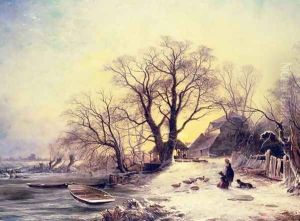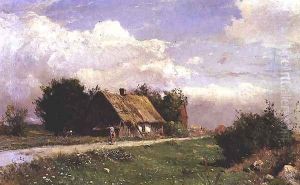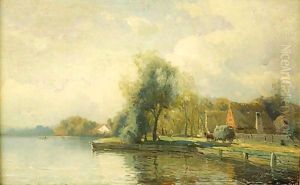Gustaf Fredrik Rydberg Paintings
Gustaf Fredrik Rydberg was a Swedish painter known for his landscape and genre paintings. Born on December 28, 1835, in Vänersborg, Sweden, Rydberg displayed an early affinity for art. He pursued his passion for painting and eventually became one of the prominent Swedish artists of his time.
In the pursuit of his art education, Rydberg attended the Royal Swedish Academy of Fine Arts in Stockholm. There, he honed his skills in painting and was particularly influenced by the Düsseldorf school of painting, a style that emphasized detail, color, and the effects of light. This influence is evident in Rydberg's landscapes, which are characterized by a meticulous approach to depicting nature and a keen observation of light and atmosphere.
Throughout his career, Rydberg painted a variety of subjects, but he is especially recognized for his idyllic landscape paintings. His works often depict the Swedish countryside, showcasing its vast forests, tranquil lakes, and the rural life of its inhabitants. These landscapes are imbued with a sense of serenity and a romantic appreciation for nature, reflecting the broader 19th-century interest in naturalism and the outdoors.
Rydberg also engaged in genre painting, which involves scenes of everyday life. His genre paintings are notable for their narrative quality, often telling stories about the lives of ordinary people in Sweden. Through these works, he captured the culture and spirit of his time, providing a window into the 19th-century Swedish society.
Rydberg's paintings were well-received, and he participated in numerous exhibitions, both in Sweden and abroad, during his lifetime. His contributions to Swedish art were recognized, and he was appreciated for his artistic talents and his dedication to capturing the essence of the Swedish landscape and its people.
Gustaf Fredrik Rydberg continued to paint throughout his life. He passed away on August 21, 1933, in Stockholm, leaving behind a legacy of art that continues to be admired for its beauty and historical value. His works are included in various collections and museums, offering insight into the Swedish landscape tradition and the 19th-century art scene.


